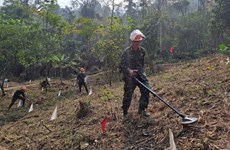Over 2.2 billion USD needed to avert further rail crossing tragedies
Over 46.7 trillion VND (2.2 billion USD) is needed to build and upgrade
facilities at crossings between railway track and roads on nine major
routes across Vietnam by 2020, according to a plan over railroad
crossings approved by the Ministry of Transport.
Over 46.7 trillion VND (2.2 billion USD) is needed to build and upgrade
facilities at crossings between railway track and roads on nine major
routes across Vietnam by 2020, according to a plan over railroad
crossings approved by the Ministry of Transport.
Under the plan, nine main routes include Hanoi- HCM City, Yen Vien town in Hanoi-Lao Cai province, Hanoi - Lang Son province's Dong Dang town, Hanoi's Dong Anh - Thai Nguyen province's Quan Trieu, Hanoi's Gia Lam - Hai Phong, Bac Giang province's Kep town - Quang Ninh province's Ha Long city, Kep town - Hanoi's Luu Xa, Hanoi's Bac Hong commune - Hanoi's Van Dien and Yen Vien - Cai Lan.
The plan targets building 57 viaducts and nearly 400 railroad crossings, upgrading over 560 crossings, and erecting over 500km of barriers to separate railway tracks from roads or residential areas.
Vice chairman of the National Committee for Traffic Safety Nguyen Hoang Hiep said that the implementation of the plan from now until 2020 was necessary in joint efforts to improve traffic safety in Vietnam.
Each year, the number of people dying in railway accidents accounts for about 2 percent of all deaths in Vietnam, and a majority of railway accidents reportedly happen at crossings, especially at illegally-built crossings, he said.
At present, Vietnam has nearly 3,200km of railway with about 6,000 railroad crossings. However, just 1,000 were built legally while the rest, illegally as shortcuts by households who live along railways, he said.
Moreover, proper barriers separating railway track and roads were erected at only one-third of the 1,000 legal crossings, and only one-third are equipped with warning signals, the other locations have neither barriers or warning signals, he said, adding that poor rail facilities posed high traffic risks.
Hiep said that under the plan, more roads running parallel to the railway would be opened to reduce the number of illegal crossings.
At crowded traffic points, viaducts or vaults could be built, he said, adding that last month, the construction of the project's first three viaducts were kicked off in northern Ninh Binh province, central Nghe An province and southern Dong Nai province.
Hiep urged localities to take more drastic measures to control safety at crossings, as it was likely that they failed to oversee the construction of the illegal crossings. The number of illegal crossings increased from 5,300 in 2011 to 6,000 last year.
Head of the Vietnam Railway Corporation's Railway Safety Management Board Pham Van Binh said that each year, it spends over 10 billion VND (474,000 USD) to correct the problems related to traffic and railways.
Moreover, he said that some accidents damaged trains, causing them to change schedules or arrange other trains to carry passengers or goods.
"Too many railroad crossings lack automatic warning systems and commuters lack proper awareness, which is a threat to traffic safety," he said.
In July, a train from Hanoi to Hai Phong derailed after a collision with a container truck in northern Hai Duong province. It was reported that the driver crossed the railway without noticing the approaching train, causing an accident which claimed no loss of life but blocked traffic on the route.
Residents living near the scene in the province's Hong Lac commune said that they saw many fatal accidents involving trains and other vehicles due to the lack of any separating barriers there.-VNA
Under the plan, nine main routes include Hanoi- HCM City, Yen Vien town in Hanoi-Lao Cai province, Hanoi - Lang Son province's Dong Dang town, Hanoi's Dong Anh - Thai Nguyen province's Quan Trieu, Hanoi's Gia Lam - Hai Phong, Bac Giang province's Kep town - Quang Ninh province's Ha Long city, Kep town - Hanoi's Luu Xa, Hanoi's Bac Hong commune - Hanoi's Van Dien and Yen Vien - Cai Lan.
The plan targets building 57 viaducts and nearly 400 railroad crossings, upgrading over 560 crossings, and erecting over 500km of barriers to separate railway tracks from roads or residential areas.
Vice chairman of the National Committee for Traffic Safety Nguyen Hoang Hiep said that the implementation of the plan from now until 2020 was necessary in joint efforts to improve traffic safety in Vietnam.
Each year, the number of people dying in railway accidents accounts for about 2 percent of all deaths in Vietnam, and a majority of railway accidents reportedly happen at crossings, especially at illegally-built crossings, he said.
At present, Vietnam has nearly 3,200km of railway with about 6,000 railroad crossings. However, just 1,000 were built legally while the rest, illegally as shortcuts by households who live along railways, he said.
Moreover, proper barriers separating railway track and roads were erected at only one-third of the 1,000 legal crossings, and only one-third are equipped with warning signals, the other locations have neither barriers or warning signals, he said, adding that poor rail facilities posed high traffic risks.
Hiep said that under the plan, more roads running parallel to the railway would be opened to reduce the number of illegal crossings.
At crowded traffic points, viaducts or vaults could be built, he said, adding that last month, the construction of the project's first three viaducts were kicked off in northern Ninh Binh province, central Nghe An province and southern Dong Nai province.
Hiep urged localities to take more drastic measures to control safety at crossings, as it was likely that they failed to oversee the construction of the illegal crossings. The number of illegal crossings increased from 5,300 in 2011 to 6,000 last year.
Head of the Vietnam Railway Corporation's Railway Safety Management Board Pham Van Binh said that each year, it spends over 10 billion VND (474,000 USD) to correct the problems related to traffic and railways.
Moreover, he said that some accidents damaged trains, causing them to change schedules or arrange other trains to carry passengers or goods.
"Too many railroad crossings lack automatic warning systems and commuters lack proper awareness, which is a threat to traffic safety," he said.
In July, a train from Hanoi to Hai Phong derailed after a collision with a container truck in northern Hai Duong province. It was reported that the driver crossed the railway without noticing the approaching train, causing an accident which claimed no loss of life but blocked traffic on the route.
Residents living near the scene in the province's Hong Lac commune said that they saw many fatal accidents involving trains and other vehicles due to the lack of any separating barriers there.-VNA












